Lithium-Metal Secondary Battery Returns
Author: Lingfang Wang
On November 4, SES (formerly known as SolidEnergySystems) held the first SES Battery World event online and launched the Apollo™ mixed lithium-metal battery with a capacity of up to 107Ah, which is currently the largest single-cell lithium-metal battery in the world with over 100Ah capacity ever shown publicly.
Apollo™ battery has a capacity of 107Ah, a weight of only 0.982Kg, an energy density of 417Wh/kg and 935Wh/L. Through third-party testing, Apollo™ battery has demonstrated high capacity and energy density in 10-hour, 3-hour, and 1-hour discharge tests carried out at room temperature.
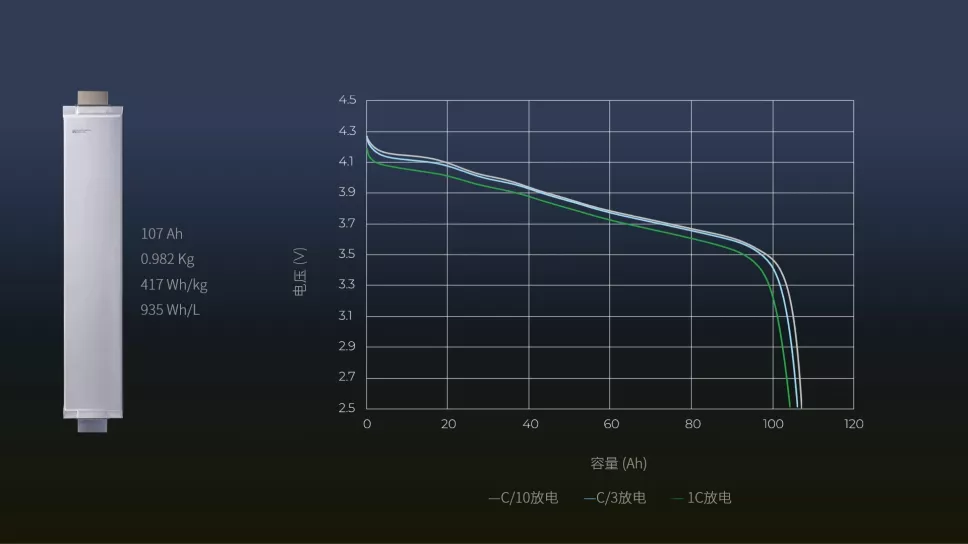
Different from lithium-ion batteries that use graphite or silicon as the negative electrode, the negative electrode of a mixed lithium-metal battery uses lithium-metal.
This is the second attempt in human history to commercialize lithium-metal secondary batteries, still using liquid electrolyte.
SES claims that they have signed a joint development agreement for lithium-metal “A” samples with General Motors and Hyundai, and will begin to launch A samples next year,with mass production set for 2025.
Before this launch, “Electric Vehicle Observer” conducted an in-depth interview with Hu Qichao, the founder and CEO of SES, to gain insight into their products, technology, and plans.
Roadmap: Mixed Lithium-Metal
Currently, solid-state batteries are the most sought-after for the next generation of batteries. As the name suggests, a solid-state battery refers to a lithium battery with a solid-state electrolyte. One of the goals of using solid-state electrolytes is to apply lithium-metal negative electrodes to significantly increase energy density.
In the first commercial attempt of lithium-metal batteries, liquid electrolyte was used.
As early as 1985, Moli Energy’s Canadian subsidiary had the first commercial application of lithium-metal batteries loaded onto “mobile phones.” However, less than six months later, a series of explosion accidents led to global recalls. The rising star Moli Energy also ended up in a sorry state.
After many attempts by scientists, lithium-metal batteries using liquid electrolytes did not break through, and people turned their attention to solid-state electrolyte solutions.
Although the solid-state electrolyte can effectively solve the problem of lithium dendrites, its ion conductivity is low, becoming another bottleneck to development.
The application of lithium-metal negative electrodes in secondary batteries is now in trouble.
If liquid and solid-state electrolytes are regarded as the first two stages of the application of lithium-metal negative electrodes, then the introduction of high-concentration electrolyte appeared around 2014, marking the beginning of the third stage.Hu Qichao explained that conventional electrolytes usually consist of two materials, namely salt and solvent. The solvent in conventional electrolytes is a type of organic carbonate salt that is highly flammable and combustible. This makes the whole electrolyte mostly flammable and very unsafe. In contrast, high-concentration electrolytes contain a lot of salt and only a small amount of solvent. The electrolyte developed by SES achieves two things. First, it is less flammable, and second, it improves the shape of lithium dendrites.
Hu Qichao introduced that they use a high-concentration electrolyte in which the solvent content is lower than that of the salt. Only a few drops of inorganic solvent is used which is not flammable. And the salt used is not the conventional lithium hexafluorophosphate, but a new one developed by themselves, with their own formula added.
In other words, although the electrolyte is still liquid, it is already less flammable. The electrolyte also improves the shape of lithium dendrites. With a conventional electrolyte, the lithium dendrites are very sharp and fluffy, which can penetrate the diaphragm and cause a short circuit and explosion. With their new electrolyte, the dendrites still form, but they are in a very round and dense, flat shape. This prevents it from piercing the diaphragm and causing a short circuit.
Furthermore, they have a protective coating on the cathode. After making the lithium dendrites very dense, they compress them, borrowing the idea from solid-state electrolytes.
Even if the dendrites are not so sharp or even flattened, the dendrite problem still exists. Therefore, they use a third method, software monitoring. They have developed a software monitoring platform called Avatar, creating a “digital twin” for each battery used in production, monitoring battery safety 24 hours a day, and predicting the battery’s development status in advance based on usage conditions, actively dealing with batteries with hidden dangers.
Hu Qichao told Electric Vehicle Observer that there are four core technologies for SES lithium metal batteries. The first is the material, that is, the electrolyte. The solvent and formula in the electrolyte are self-developed and less flammable, making them safer. At the same time, it is a very stable liquid when combined with lithium metal.
The second is lithium metal itself. Although lithium metal is purchased, it is still a challenge to make it into an ultra-thin, ultra-wide lithium foil or tape in terms of production technology. SES is cooperating with some suppliers to develop this technology.The third aspect is cell manufacturing, with SES producing their own cells. Although lithium-metal batteries and lithium-ion batteries are quite similar, there are still many differences between the two, which is where this aspect becomes their core technology.
The fourth aspect is software. Beginning from the control of raw material quality during cell production, SES collects data through the entire manufacturing process. Through this software, the company can precisely monitor the operating conditions of each cell and predict potential risks, allowing them to “sound an alarm one month in advance.”
Hu Qichao explained that their hybrid lithium-metal battery combines the high energy density of lithium metal and the high manufacturability of lithium ions, bringing out the strengths of both.
Advantages: Performance similar to lithium-ion batteries, but with significantly improved energy density
When using the same positive electrode as that of a lithium-ion battery, the application of metallic lithium as the negative electrode can significantly increase the energy density of the battery. The data provided by SES shows that the Apollo™ battery has a capacity of 107Ah, weighs only 0.982Kg, and has an energy density of 417Wh/kg and 935Wh/L.
Hu Qichao told “Electric Vehicle Observer” that 400Wh/kg is the starting point for the energy density of lithium-metal batteries, and in the future they will continue to optimize it, possibly reaching 480Wh/kg or even 500Wh/kg depending on demand.
If the data is accurate, this has already exceeded the current market energy density of lithium-ion batteries.
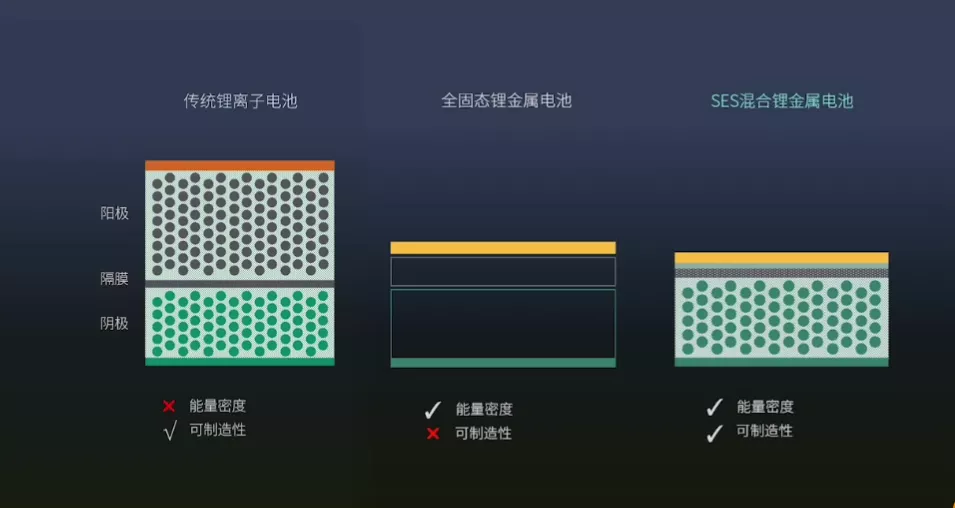
What about safety, low-temperature performance, and lifespan?
Perhaps due to the recent successful manufacture and limited testing of the ApolloTM battery, they have only provided discharge testing data for three different environments: 10 hours, 3 hours, and 1 hour. From the data, both the energy density and capacity are very close.
Of course, SES provided more data for reference from their 4Ah small cell.
According to third-party testing, their small cells can pass needle puncture, overcharge, external short circuit, and high-temperature tests. As Hu Qichao put it, lithium-metal batteries can achieve safety performance similar to that of lithium-ion batteries.
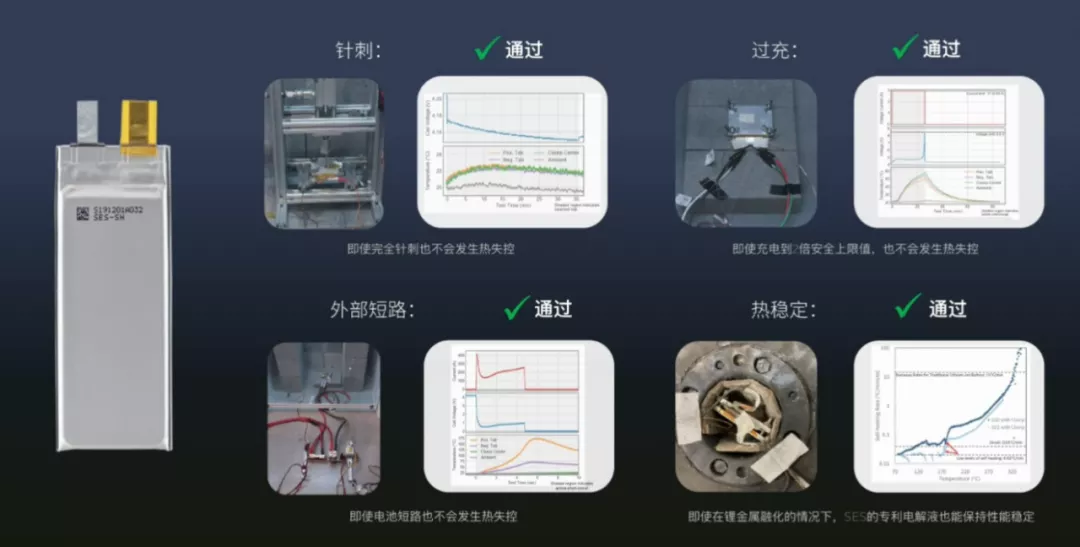
Regarding rate capability and low-temperature performance, they have conducted relevant testing. Hu Qichao stated that their battery testing showed consistently high energy density from 40 degrees to minus 30 degrees Celsius, from very slow discharge (10 hours) to extremely fast discharge (less than 10 minutes).
The small cells can charge at a rate of up to 4C and discharge as quickly as 10C.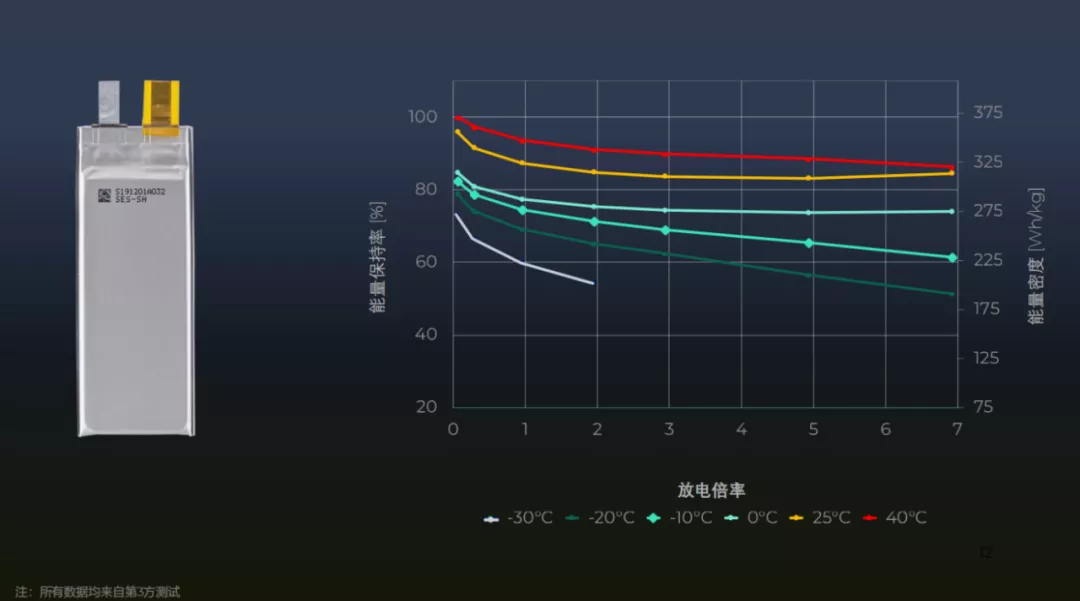
In addition, lithium-metal batteries can also be fast charged. Third-party test data shows that their lithium-metal batteries can be charged from 10% to 90% in just 12 minutes.
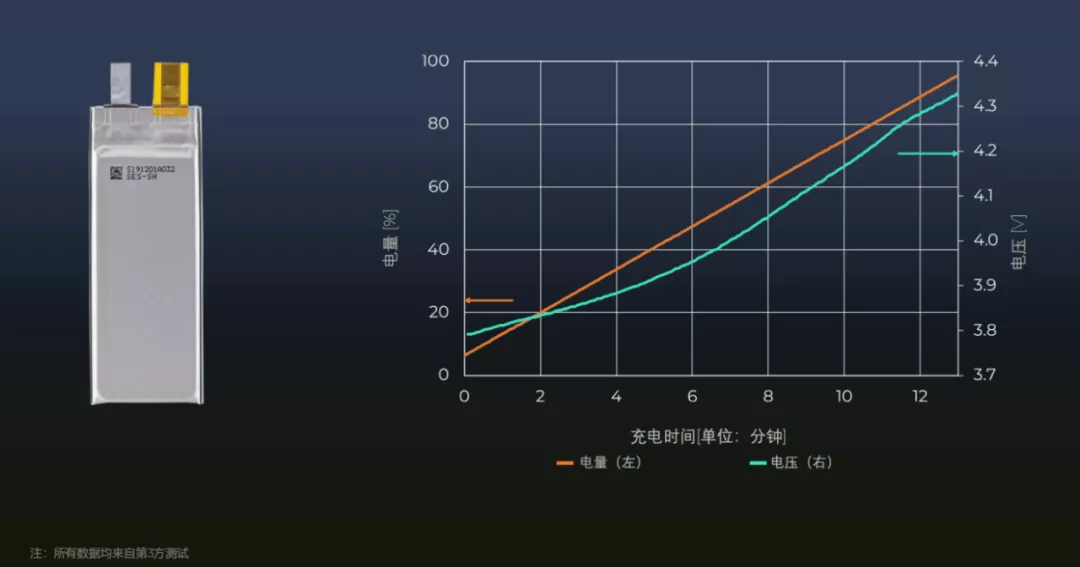
Regarding lifespan, according to data provided by SES, 3/4 layers of 250mAh batteries can maintain 80% capacity after 800 cycles, while 25+ layers of 4.2Ah batteries can maintain 90% capacity after 550 cycles.
Hu Qichao stated that the entire production process and supply chain of their lithium-metal batteries are very similar to those of lithium-ion batteries, with 60% of the processes being shared, and the main difference being in negative electrode production. Thus, the ability to produce hybrid lithium-metal cells will be very good.
For the positive electrode material, according to the needs of the car manufacturer, SES can use the positive electrode materials of lithium-ion batteries, such as ternary and lithium iron phosphate. It is precisely because of this that the performance of hybrid lithium-metal batteries is very similar to that of lithium-ion batteries.
Progress: A sample in the next year, mass production in 2025
SES is currently working with General Motors and Hyundai Motor to launch automotive-grade lithium-metal battery A samples next year.
Hu Qichao explained that their plan is to launch A samples in 2022, B samples in 2023, C samples in 2024, and begin mass production around 2025.
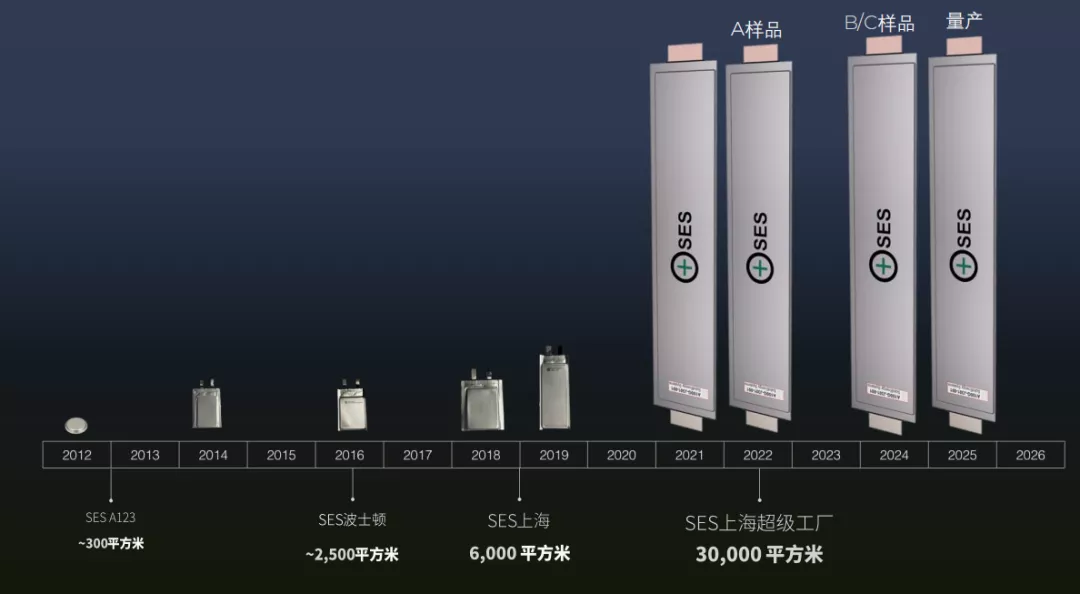
SES is building a super factory in Shanghai, which is expected to be completed in 2023, and will have a total area of 30,000 square meters. The super factory is located in Jiading International Automobile City in Shanghai. Once completed, the production capacity will reach 1GWh, making it the largest lithium-metal battery factory in the world.
By 2025, SES will establish joint ventures with car manufacturers. The goal for 2025 is to start construction of a 10GWh factory and further increase the production capacity to 30GWh by 2028.
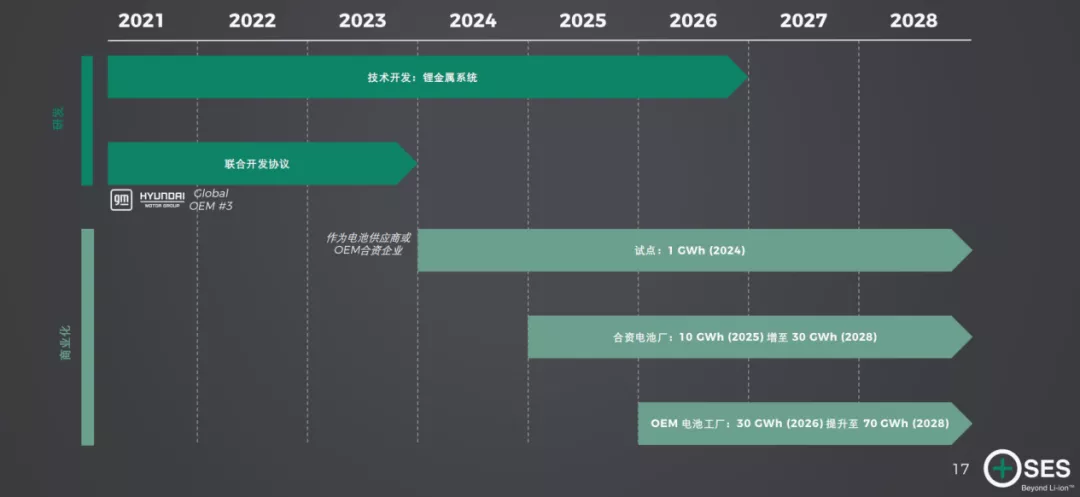
As for the layout of the production site, it is based on the principle of proximity to the car manufacturer.In Hu Qichao’s view, there are three steps in the entire battery industry chain. Firstly, the material development in which the United States has advantages. Secondly, the development and production engineering of the battery core products which must be based in China and South Korea due to their industrial chain advantages. Thirdly, in terms of production, being close to the automakers is generally required. For example, Ningde’s factory in Germany mainly services German automakers, while LG and SK build factories in the United States mainly to serve American automakers. “If we serve American automakers, we should build factories in the United States; if we serve Asian automakers, we should build factories in Asia; if we serve European automakers, we should build factories in Europe.”
Hu Qichao is very confident about the mixed lithium metal battery. He states that SES does not care whether it is a solid-state battery or a mixed-state battery; their only concern is the data that can be truly repeated. They have tried solid-state batteries before and found that their performance and producibility were far inferior to those of mixed lithium metal batteries, which is why they chose mixed lithium metal batteries.
It must be emphasized again that currently, most of the data provided by SES comes from the 4Ah small battery cell. It will not be until next year when more data will be available for the 100Ah large battery cell. Moreover, as a brand-new product, from the A sample to mass production, Apollo still needs to go through large-scale production, vehicle matching testing and verification, as well as actual vehicle application. With many steps ahead and many challenges to overcome, whether Apollo can smoothly enter mass production and be installed in vehicles remains to be seen.
This article is a translation by ChatGPT of a Chinese report from 42HOW. If you have any questions about it, please email bd@42how.com.